In today’s article, Massad Ayoob takes a looks at the Springfield Armory 1911 all-black Emissary 4.25” in .45 ACP. He tested it out at his personal range and also the annual Pin Shoot held in Michigan. How did it perform? Read on to get Ayoob’s take on it. The pistol was loaned to Ayoob for this article.
Long-time readers of my work here on The Armory Life know that I am a devoted fan of the annual Pin Shoot event held in Michigan. This year, the Concealed Carry division upped the allowed barrel length from 3.5” to 4.25”, allowing for the popular “Commander”-size 1911s to be included.
Well, I saw this as an excellent opportunity to try out a Springfield Armory 1911 I have been looking at recently — the all-black 4.25” Emissary in .45 ACP. So, I reached out to the company and asked if they could send out a loaner model.
The Springfield Armory website describes the Emissary thus: “Built on a durable foundation of forged steel in its barrel, slide and frame, the Emissary offers a defensive pistol with an air of custom refinement. The pistol has a beautiful two-tone or all-black finish, with squared trigger guard. A ‘Tri-Top’ cut to the slide gives the pistol custom-grade styling, while a heavy-profile bull barrel delivers maximum accuracy and reduces felt recoil.”
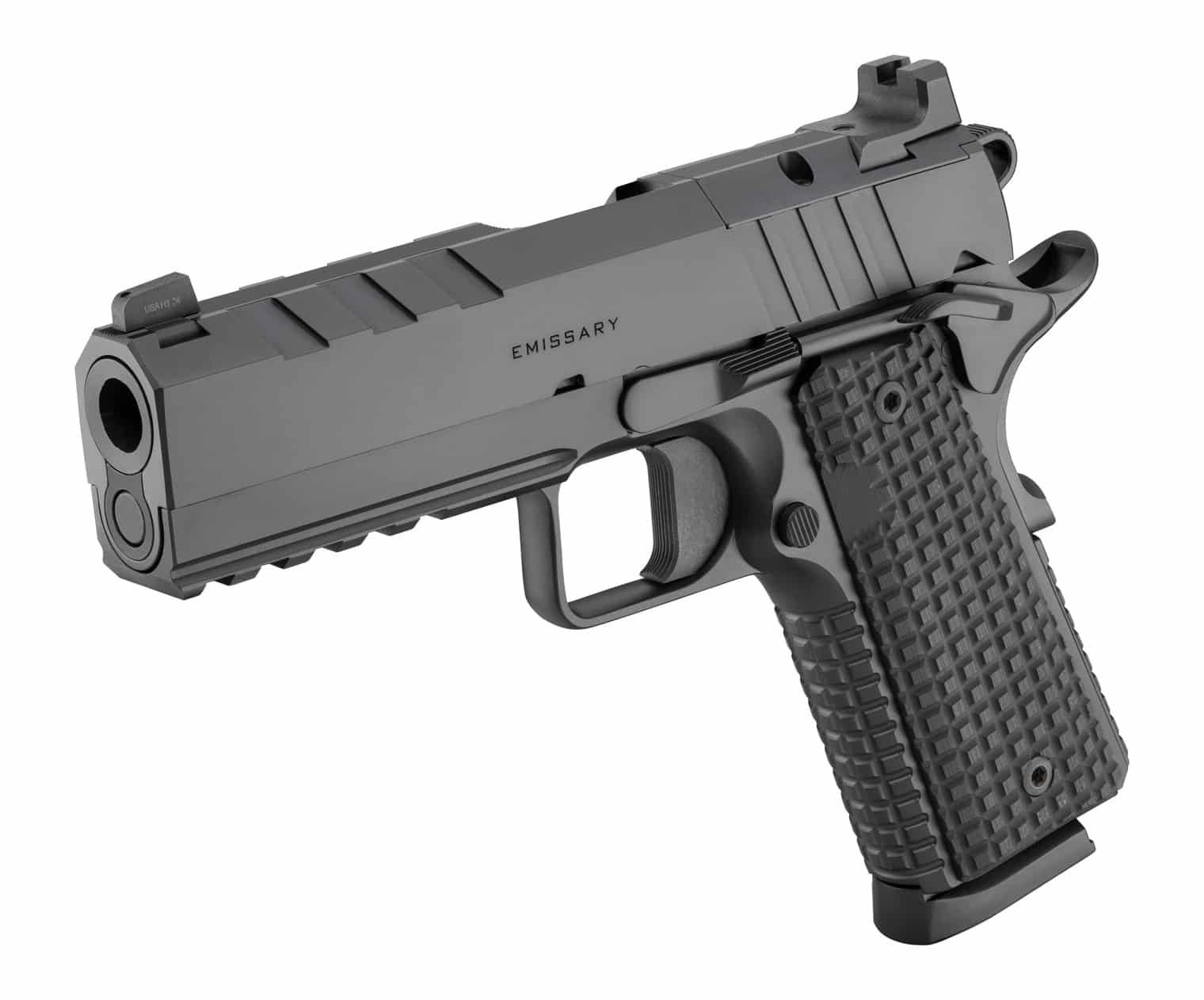
Of course, there’s more. The finish is a businesslike black Cerakote. Our handgun had the nicely balancing 4.25” barrel and VZ slim-line G10 grips complemented by well-shaped “grenade grip” checkering on the front strap of the grip frame and the flat mainspring housing. It being 2025 after all, it came optics-ready. Springfield explains, “The Agency Optics System (AOS) adds versatility, fitting popular footprints like RMR, Shield, Delta Point Pro, and Docter. Each AOS plate has an integral rear sight for proper optic height and a visible co-witness in nearly all configurations, enhancing precision and defensive capability.”
I tested it with the excellent fixed iron sights; high for BUIS (Back-Up Iron Sights) if an optic is mounted, but fine as is. The rear sight is a U-notch, while the front is a high, slightly slanted post mounting a big green dot with a tritium night-sight ball in the center and surrounded by a luminescent ring. The full-length dust cover is cut for white light/laser sight attachments. Our firearm, serial number NM 808729, also has a squared smooth-front trigger guard and flat trigger.
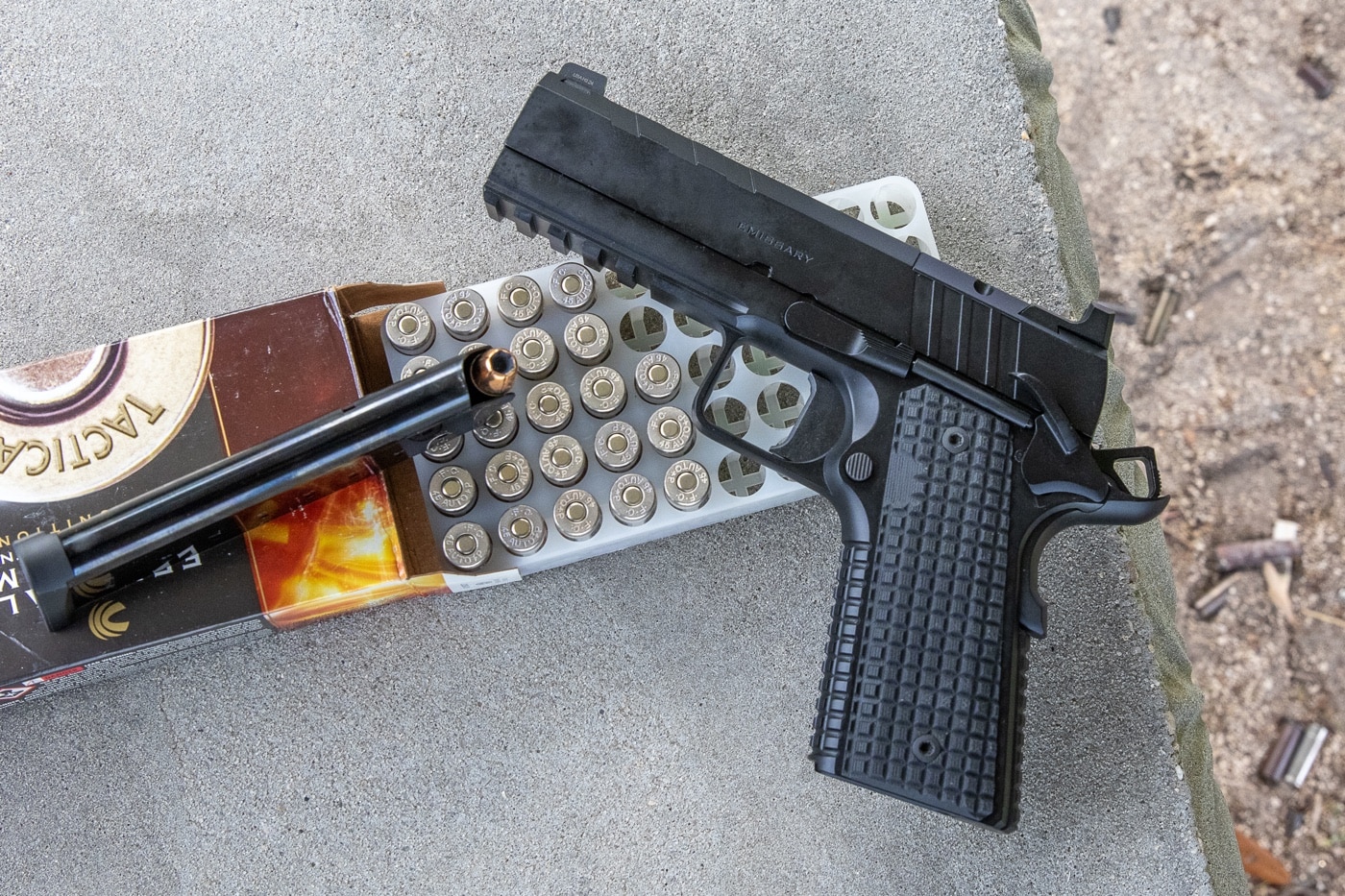
The Emissary’s 4.25” bull barrel and monolithic out-to-the muzzle dust cover combine to give this pistol “stand-off” capability. That is, with the muzzle pressed straight against a surface, parts remain in battery and the hammer will fall when the trigger is pressed. Most conventional 1911s will “go out of battery” under those circumstances; that is, the parts will no longer be in alignment for the gun to fire. In a defensive pistol, this is a potentially life-saving feature (although Springfield Armory does not advertise it as such).
The 4.25” Emissary is a solid chunk of handgun, spec’d to weigh 40 ounces unloaded, about a quarter pound more than a standard configuration 1911 .45 with the same length barrel and the same all-steel frame. The weight, along with the strong recoil spring, seems to mitigate recoil somewhat.
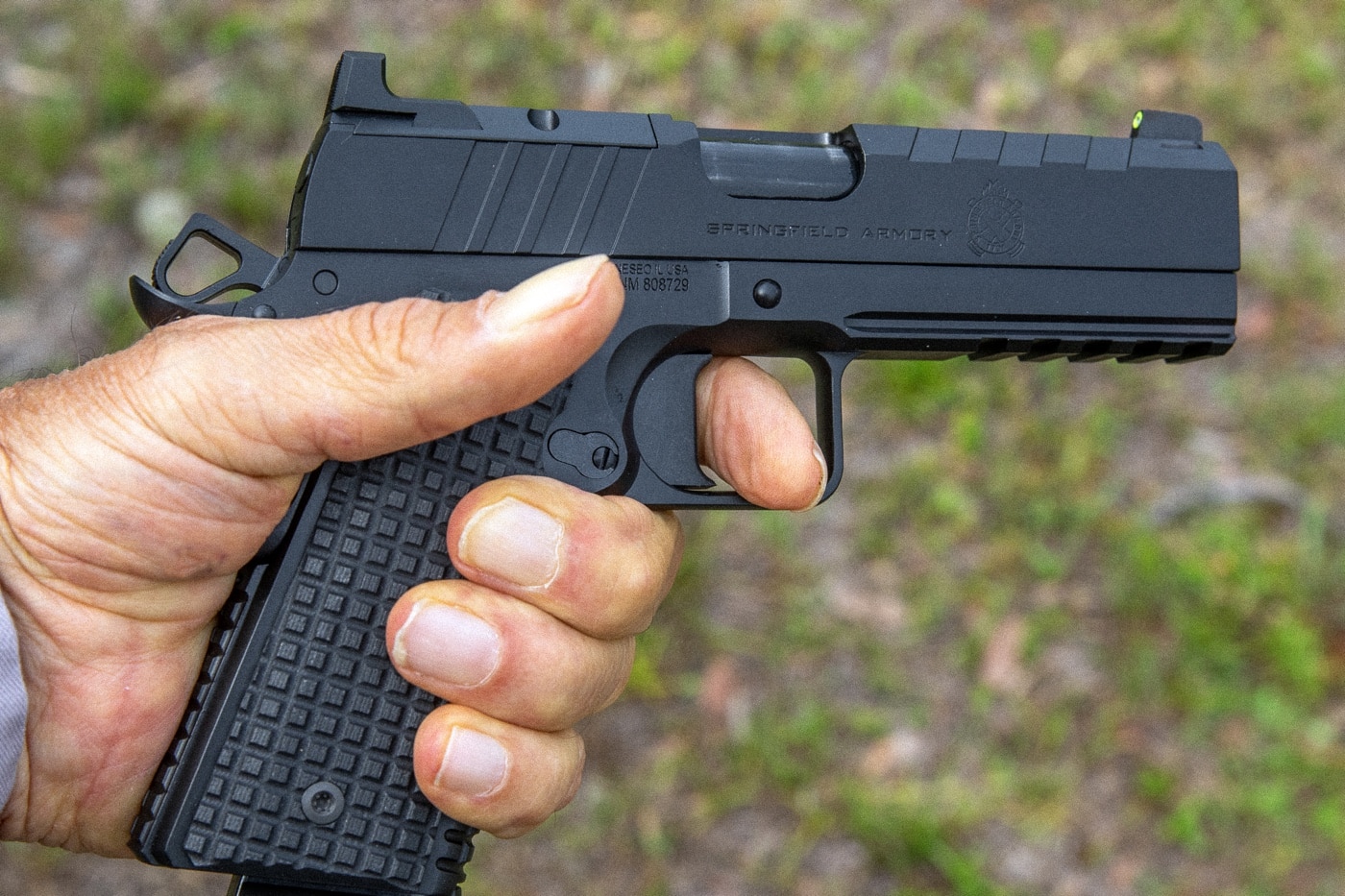
As to the styling, my wife, a self-described shooter-chick and also a devotee of fine architecture, examined the gun and told me, “It’s in the Modernist style with a touch of Brutalism. (Which doesn’t mean in architect-speak what it means in plain English.) The design is all about function, and an update from the conventional 1911 style. The touch of Brutalism comes from the materials, like the steel looking like steel, thus emphasizing the raw materials used in the construction.”
Shooting the Emissary
Before I took the Emissary to the Pin Shoot match, I wanted to wring it out at the range and get some rounds through it. The recoil spring was heavy out of the box. I found the slide stop to be very tight in the new gun and simply pulled back on the slide to run the action on a freshly inserted magazine.
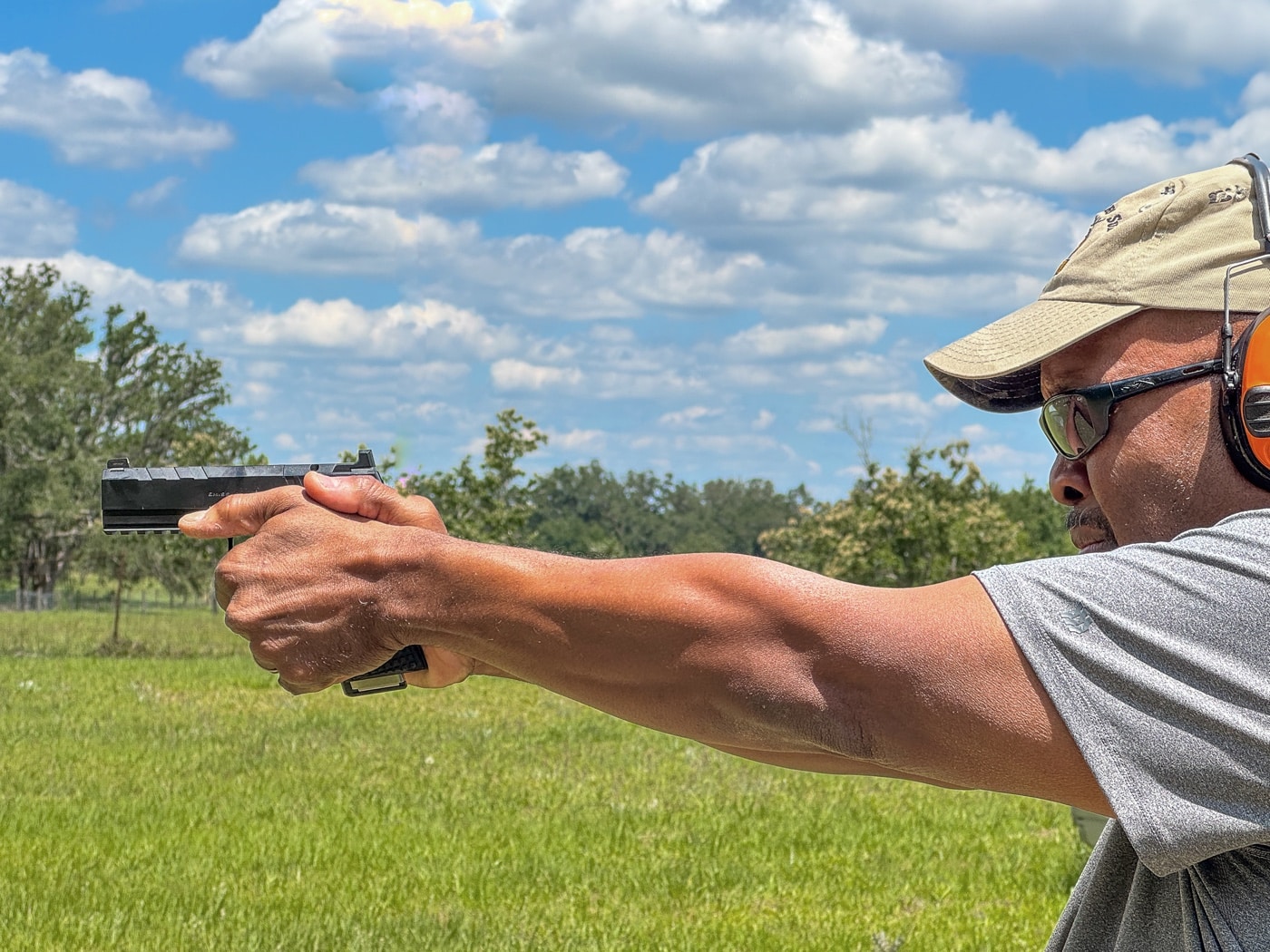
The furnished magazines were easy to load with all eight fat .45 sluggers, and the magazines seated easily and positively when inserted with the slide forward as on a tactical reload. That’s something that can’t be said of all eight-round 1911 .45 mags.
Trigger break was crisp and clean. The sculpturing of this particular model and its grips allowed an average-sized adult male hand to get the index finger centered on the flat face of the trigger, a placement which gives the shooter more leverage.
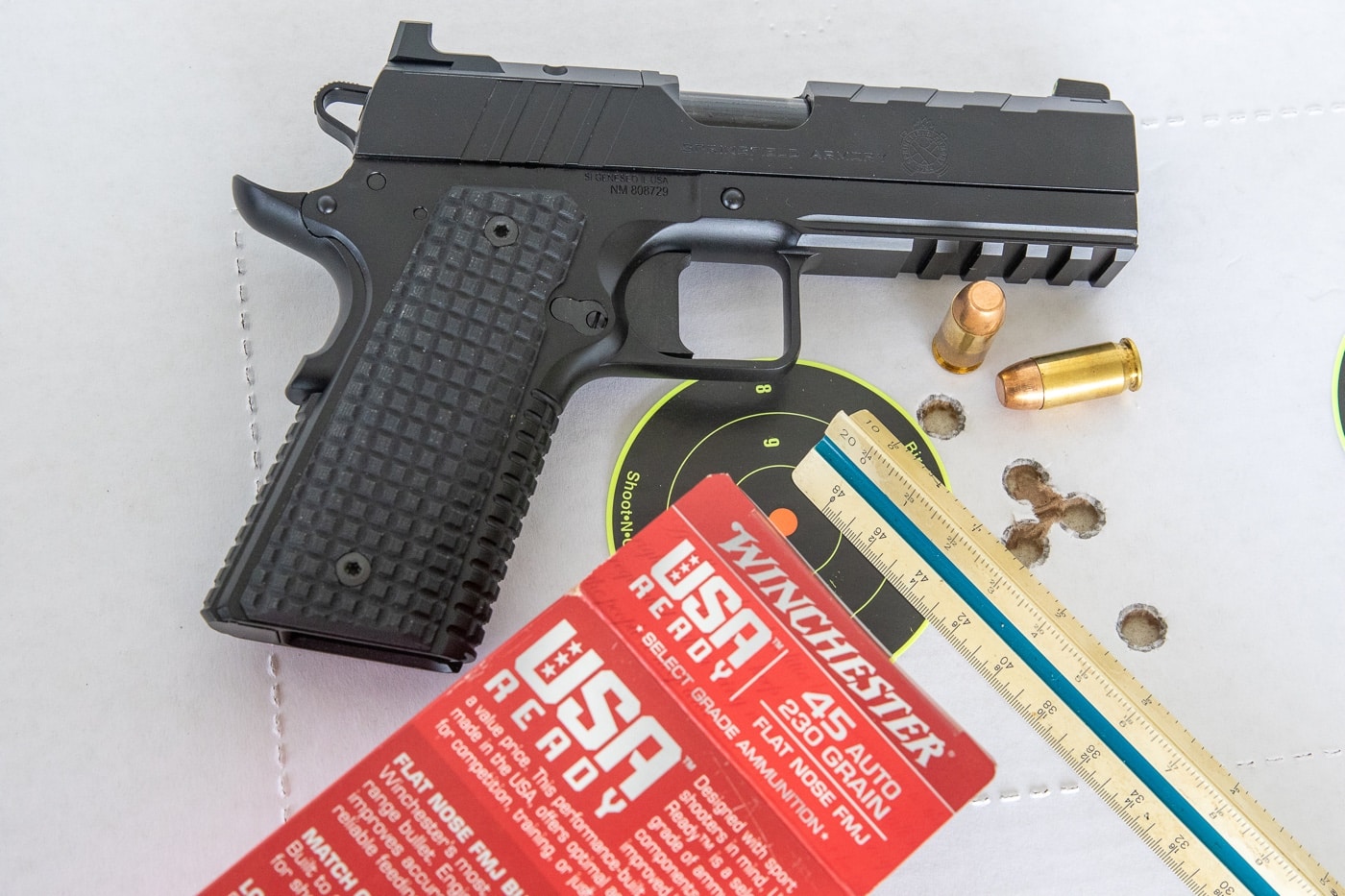
Trigger pull weight, measured on a Lyman digital scale, averaged 4.81 pounds. There was no palpable backlash or rearward trigger movement after the sear released. Reset was short and consistent, always a help in accurate rapid fire. That 4.81 pounds is good for a self-defense gun: it does not fit the definition of a hair trigger but remains easy to manipulate at speed.
Accuracy testing encompassed the two most popular .45 ACP bullet weights, the two most popular bullet styles (full metal jacket for practice, jacketed hollow point for defensive use), and both standard pressure and +P. The Caldwell Matrix rest was set on a concrete bench at 25 yards. Each group was measured twice: once for all five shots (to get an idea of accuracy potential in experienced hands under ideal conditions) and once again for the tightest three shots, which experimentation has shown will roughly equal what all five would have done from a machine rest to get a good idea of inherent mechanical accuracy.
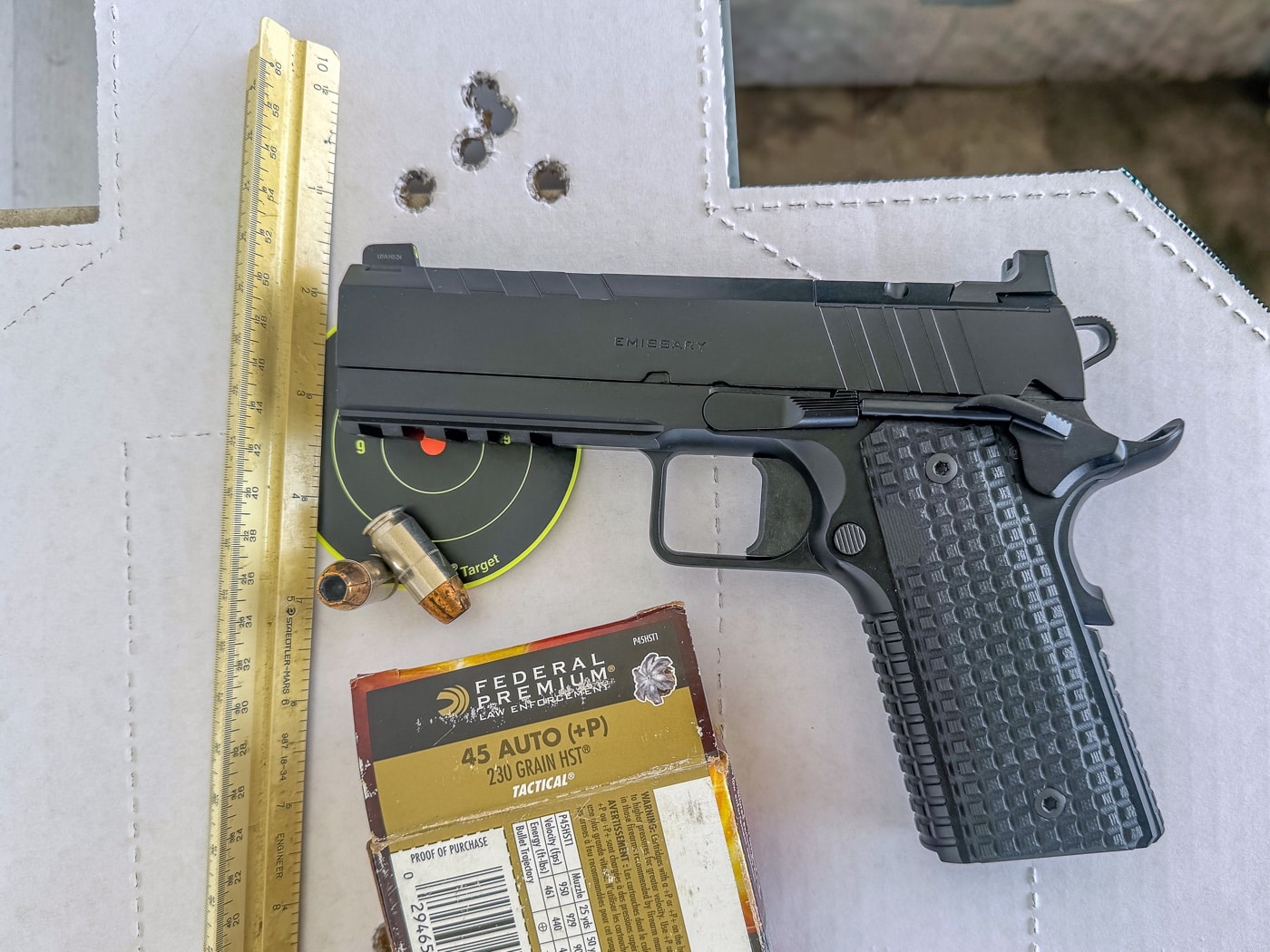
The 230-gr. full metal jacket is far and away the most popular practice and training configuration for .45 ACP ammo, and was represented here with Winchester’s flat-nose “USA Ready” brand. The five shot group measured 2.45” center to center, measured to the nearest 0.05”, but the best three measurement factored out unnoticed human error and measured well under an inch, 0.60”.
The 185-gr. Winchester white box .45 ACP with a flat-nosed full metal jacket was the Emissary’s least favorite load in the test, measuring 3.90” for all five but a more pleasing 1.85” for the best three.
The star of this particular test was one of my very favorite police duty/defensive carry .45 ACP loads, the Federal HST 230-gr. +P jacketed hollow point rated for 950 feet per second out of a standard service pistol. I’ve seen this bullet mushroom to a full inch in diameter, still reaching optimum penetration depth. From the Emissary, it delivered a 1.25” group, with four of them in 1.20” and the best three in a most impressive 0.60” group, six tenths of one inch, tying the 230-gr. Winchester USA Ready ball in that respect.
The “NM” in this pistol’s serial number refers to its National Match barrel, “National Match” being 1911-speak code for extreme accuracy. Suffice to say, the Emissary delivered.
Match Tested
As noted, I acquired the Emissary to try out at the Pin Shoot. Since the targets are heavy bowling pins that have to be blown back three feet off the tables they rest on, the 4.25” Emissary seemed ideal for this kind of event. The course involves six tables of five pins each, interspersed with blue “hostage pins” which cost a five-second time penalty apiece if knocked over. The best five out of six tables count for your score. In the Concealed Carry event, you can only have six rounds in the pistol to start but are allowed to reload.
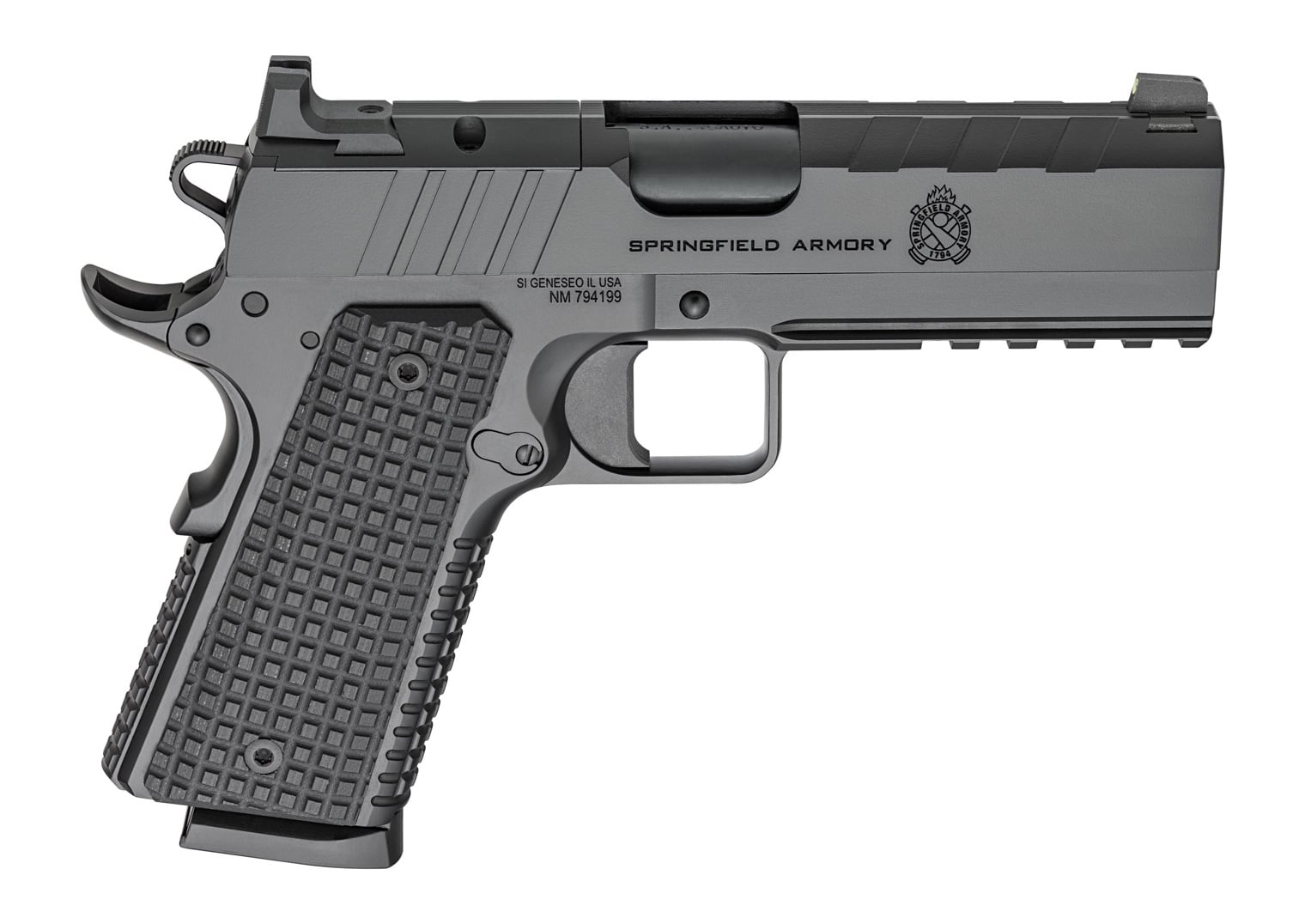
The Emissary gave a good account of itself. That big front sight seemed to bring itself target to target. Three of the six tables went “clean” in front of the gun, the hot HST 230-gr. +P reefing the pins away with alacrity, five for five. On two of the tables, I needed a sixth shot, one for a miss and one for a pin hit off-center that needed some help leaving the table.
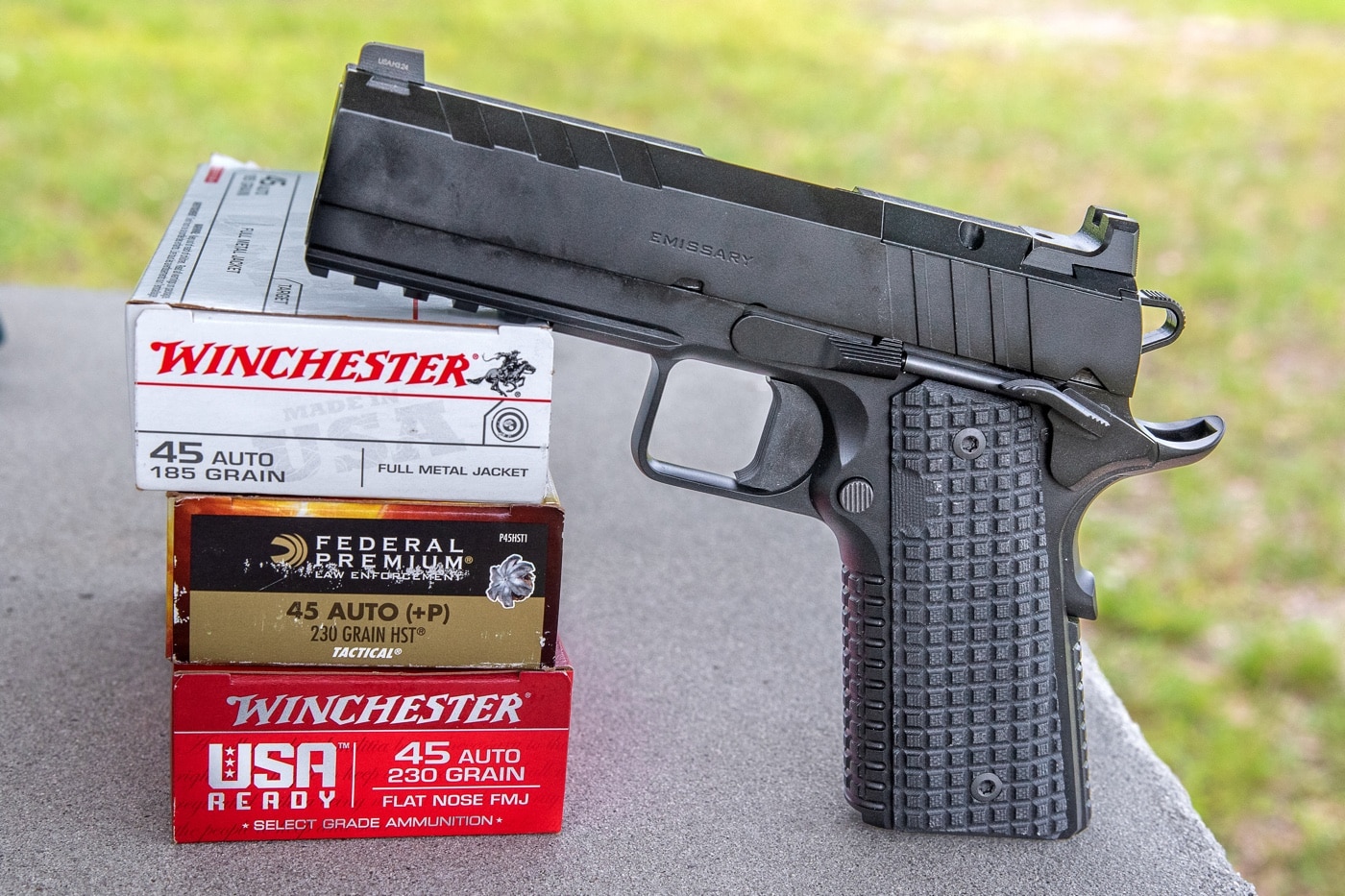
On the last run, figuring on a throwaway, I put the pedal to the metal and raced it … and went off the road. The gun went to slide-lock with “deadwood” still on the table. I had pushed it too fast and missed. A quick magazine exchange and slide tug let me nail the rest. Still, the best five runs yielded a still-respectable total and I finished in the prizes, winning a nice Benchmade knife. The Emissary had come through.
Summary
The definition of “emissary” is a representative, sometimes sent on special missions. This particular Emissary does an excellent job of representing its manufacturer, Springfield Armory. Its excellent build quality, feature set and performance are commensurate with its $1,378 suggested retail price.
Editor’s Note: Please be sure to check out The Armory Life Forum, where you can comment about our daily articles, as well as just talk guns and gear. Click the “Go To Forum Thread” link below to jump in and discuss this article and much more!
Read the full article here

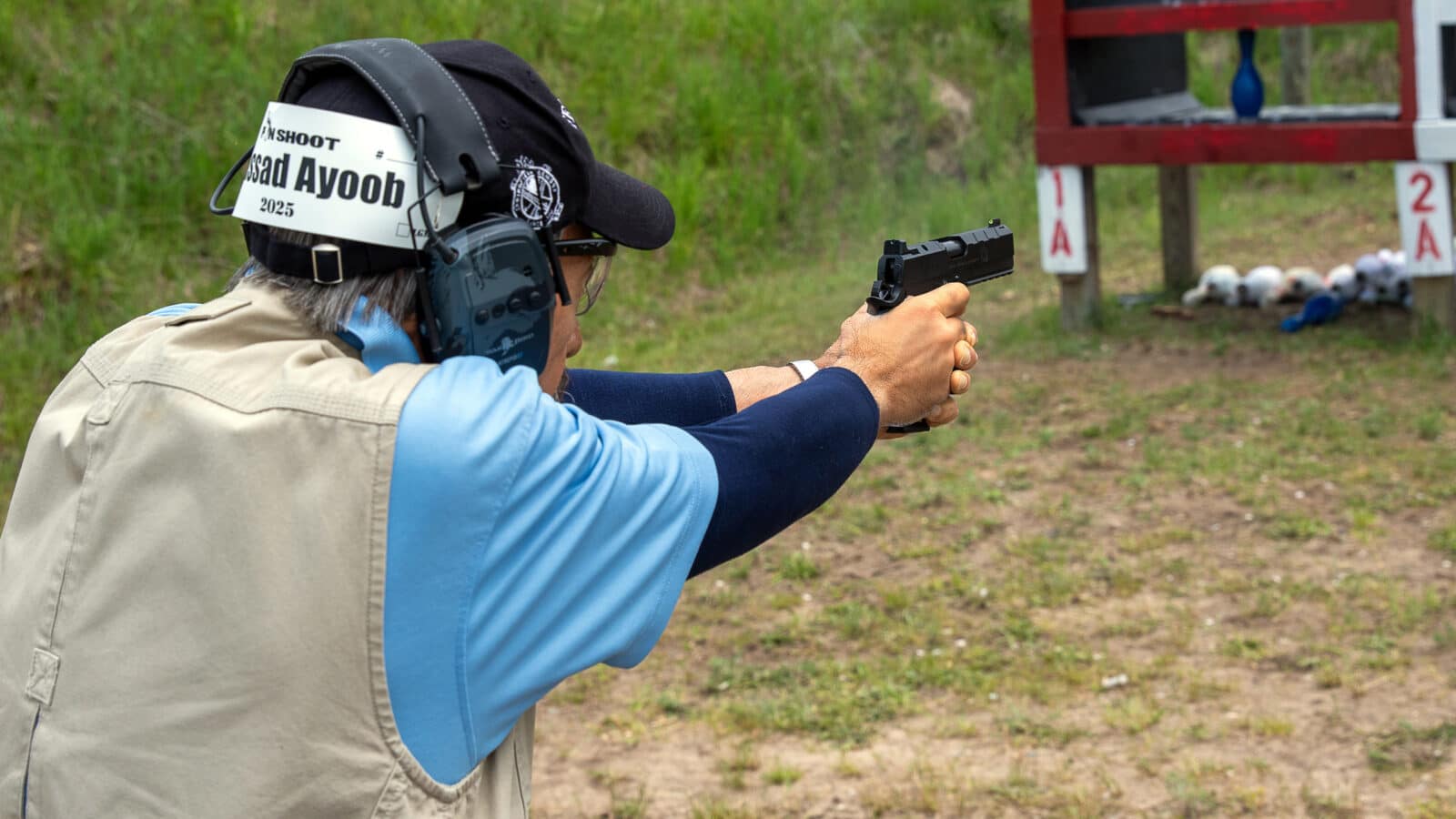




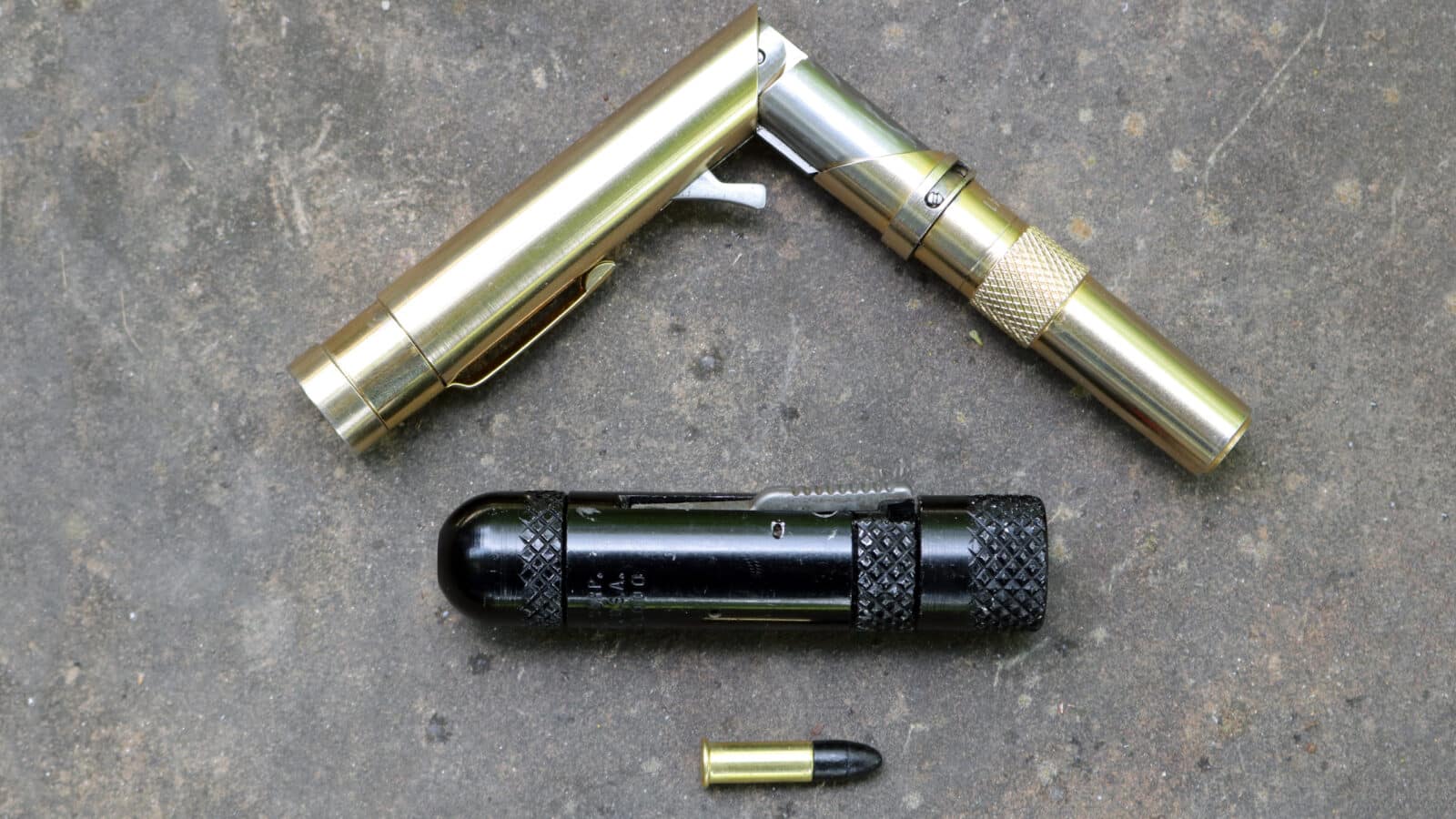

Leave a Reply